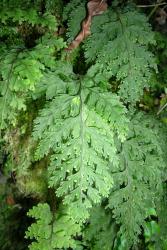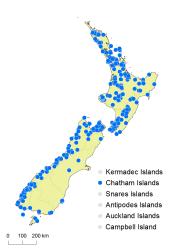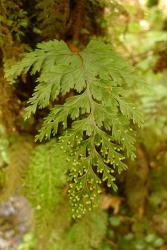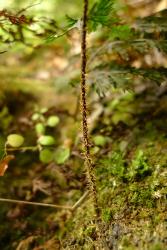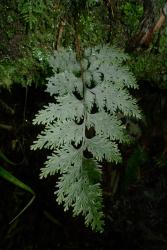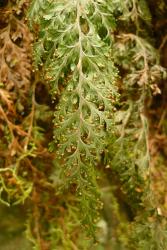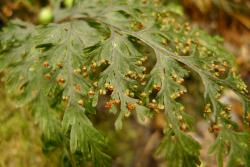- ≡ Sphaerocionium scabrum (A.Rich.) C.Presl, Hymenophyllaceae 34 (1843)
- ≡ Diploophyllum scabrum (A.Rich.) Bosch, Verslagen Meded. Afd. Natuurk. Kon. Akad. Wetensch. 11: 323 (1861)
- ≡ Mecodium scabrum (A.Rich.) Copel., Philipp. J. Sci. 67: 24 (1938)
- = Sphaerocionium glanduliferum C.Presl, Epimel. Bot. 22, t. 12 (1851)
- = Hymenophyllum scabrum var. hirtum Colenso, Trans. & Proc. New Zealand Inst. 13: 379 (1881)
Epiphytic, terrestrial or rupestral ferns. Rhizomes long-creeping, 0.5–1.0 mm diameter, bearing abundant pale brown hairs up to 1 mm long, clustered at bases of stipes. Fronds 100–780 mm long. Stipes 40–170 mm long, dark brown throughout, not winged, densely covered in bristly hairs up to 5 mm long. Laminae usually 4-pinnatifid, rarely 3- or 5-pinnatifid, ovate or elliptic, 65–630 mm long, 40–150 mm wide, olive-green, membranous, 2–4 cells thick, with scattered hairs on costae and especially at bases of indusia. Rachises narrowly winged for most of their length, dark brown, bearing bristly hairs; rachis wings planate. Primary pinnae in 10–25 pairs, scarcely overlapping, winged throughout, narrowly ovate or ovate, adnate; distal portion of primary pinnae straight or slightly incurved acroscopically; the longest primary pinnae at or below the middle, 25–140 mm long, 14–50 mm wide. Secondary pinnae arising both acroscopically and basiscopically, scarcely overlapping, ovate to elliptic, winged throughout, adnate; the longest secondary pinnae 12–39 mm long, 6–18 mm wide. Ultimate lamina segments oblong, up to 4 mm long, 0.6–1.4 mm wide; apices obtuse or truncate; margins entire, lacking a distinct border; distal segments on primary pinnae divergent or slightly curved towards frond apex. Sori borne on acroscopic and basiscopic segments at the distal ends of the pinnae, solitary, many on each primary pinna, adnate or slightly immersed in lamina; indusia bivalvate; indusial flaps broadly elliptic or broader than long, 0.75–1.5 mm long, apices obtuse or truncate, margins minutely or irregularly toothed, bearing capitate hairs when young, outer surfaces hairy at base; receptacles included within indusial flaps.
Hymenophyllum scabrum is a large filmy fern easily recognised by its olive-green laminae, segments with entire margins, and long bristly hairs on the stipe and indusial flaps, with the latter being minutely toothed and often broader than long.
North Island: Northland, Auckland, Volcanic Plateau, Gisborne, Taranaki, Southern North Island.
South Island: Western Nelson, Sounds-Nelson, Marlborough, Westland, Canterbury, Otago, Southland, Fiordland.
Chatham Islands, Solander Island, Stewart Island.
Altitudinal range: 0–1100 m.
Hymenophyllum scabrum occurs in lowland and montane areas of the North Island from the Mangamuka Range southwards. It ranges from sea level, reaching 1100 m on Mt Taranaki and Mt Hauhungatahi. In the South Island it occurs in lowland and montane areas of the Marlborough Sounds, north-west Nelson, Westland, Fiordland and Southland, extending to Dunedin and a few scattered localities in Marlborough and Canterbury. It reaches 925 m on Key Summit.
Occurs in kauri, podocarp, beech and broadleaved forest growing on the ground, on rocks, banks, rock faces, rotten logs and stumps, and as an epiphyte. It has been recorded growing on Cyathea dealbata, C. medullaris, Dicksonia fibrosa, D. squarrosa, Coriaria arborea, Fuchsia excorticata, Griselinia littoralis, Lophozonia menziesii, Prumnopitys taxifolia, Pseudowintera colorata, Schefflera digitata, and Weinmannia racemosa.
n = 36 (Brownlie 1958).
Hymenophyllum scabrum, together with H. dilatatum and H. nephrophyllum, is unusual in the genus in having a frond that is more than one cell thick. Holloway (1923) showed that sporelings had a lamina only one cell thick and that the multi-layered condition developed with maturity.



